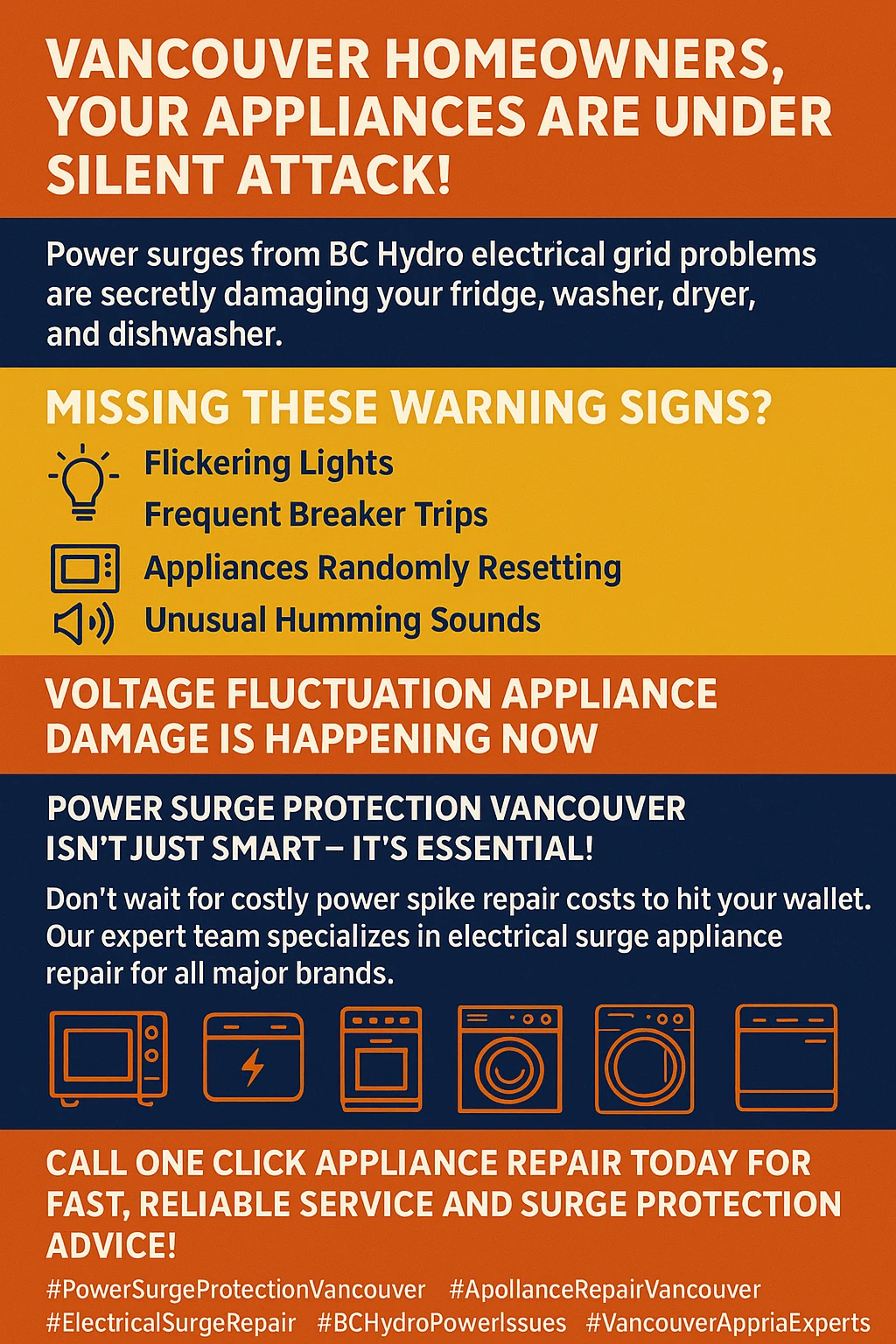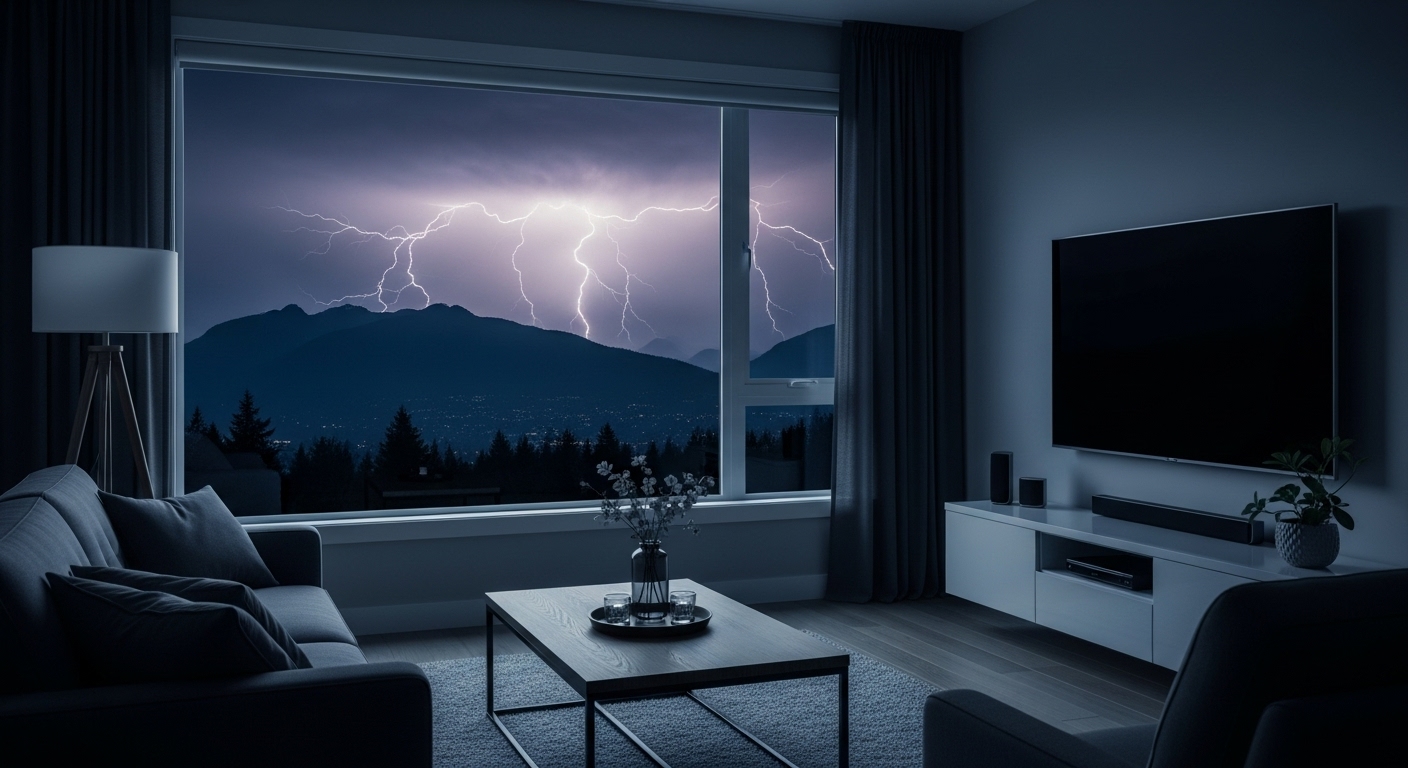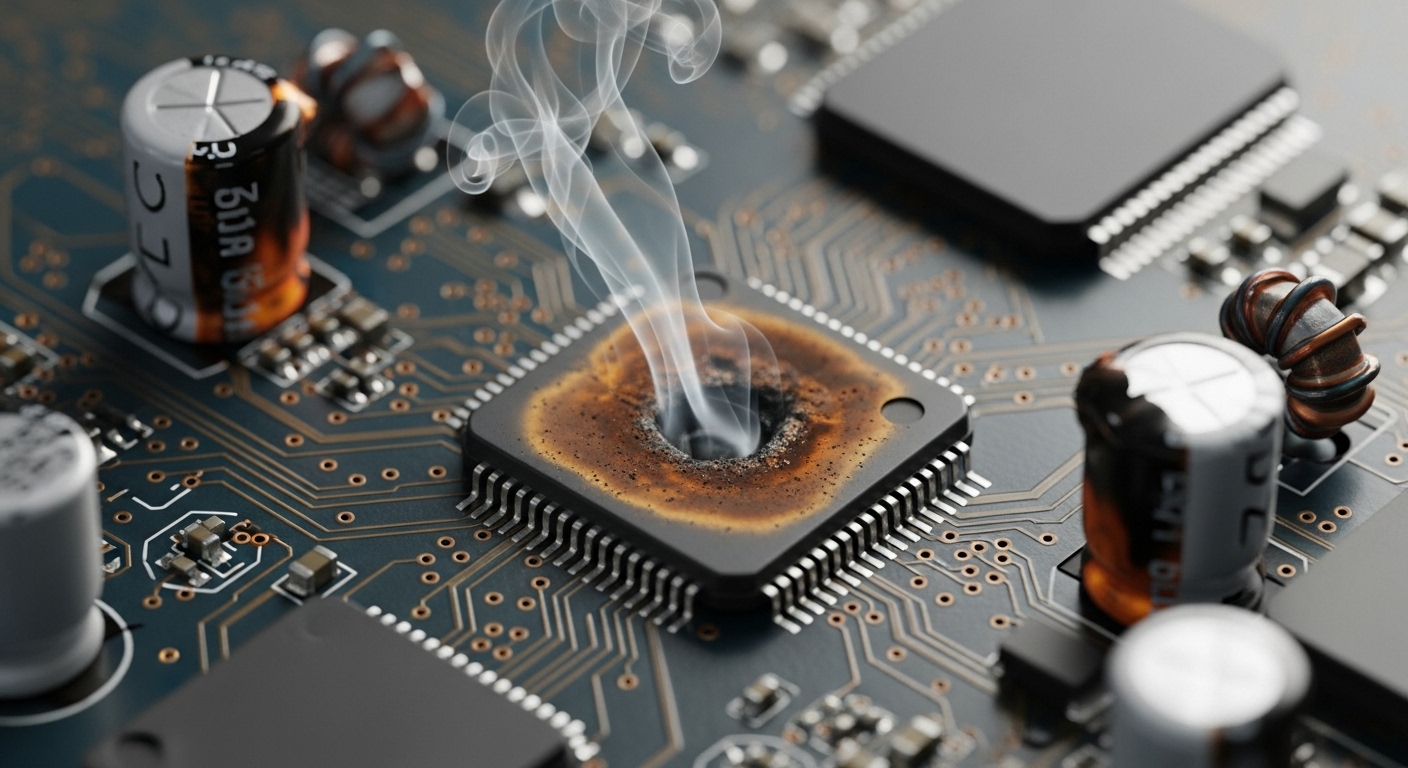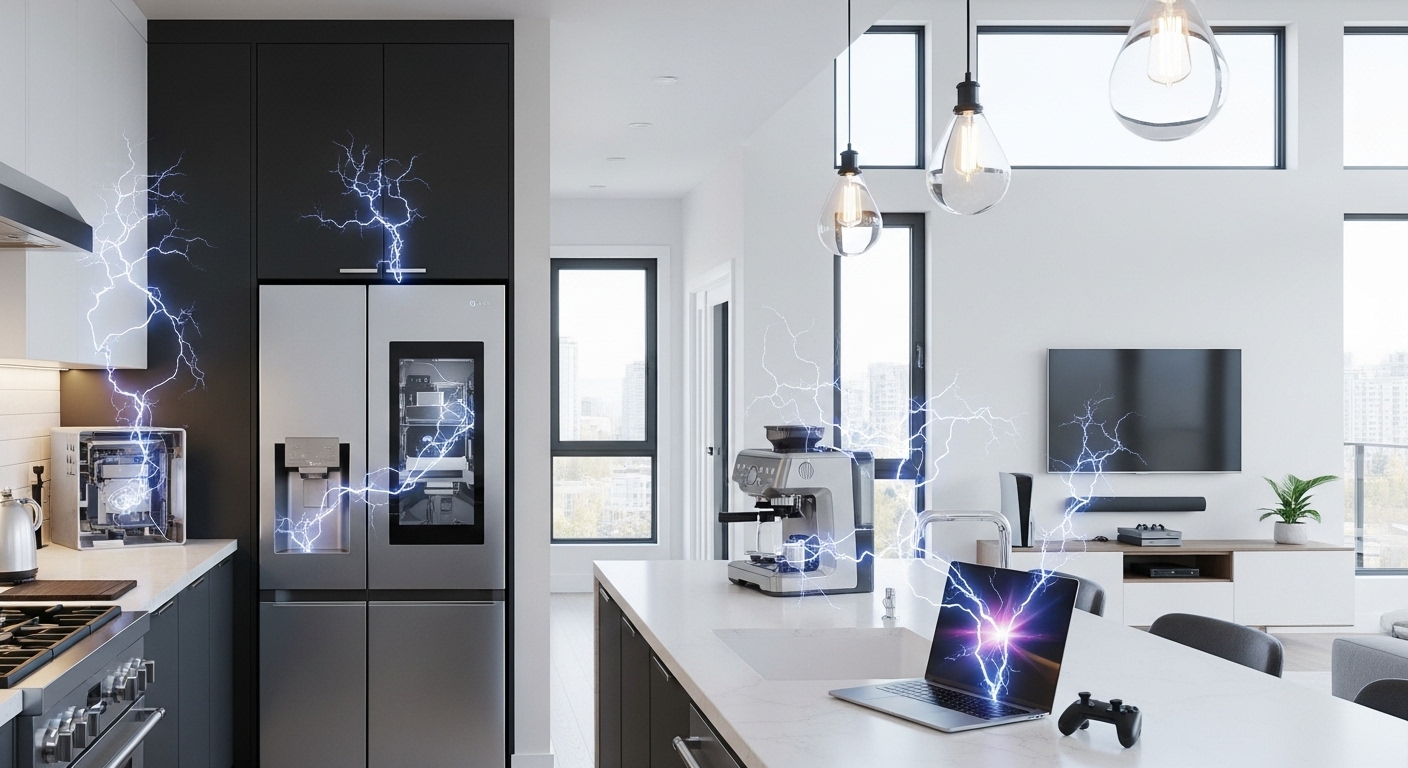Vancouver’s Power Surge Problem: How Electrical Issues Are Silently Killing Your Appliances (And the Warning Signs You’re Missing)
Worried about your expensive Vancouver appliances getting zapped by the next power surge? You’re absolutely right to be concerned – these electrical spikes happen way more often than most homeowners realize, and they can turn your favorite gadgets into expensive paperweights faster than you can say “lightning strike.”
Picture this: you’re chilling at home in Vancouver on a stormy Tuesday night, binge-watching your favorite show, when suddenly the lights flicker and your smart TV goes black. Not just any black – that scary, permanent kind of black that means you’re about to have a very expensive conversation with an appliance repair technician. If this scenario gives you the shivers, you’re definitely not alone in the Lower Mainland.
The thing is, power surges in Vancouver aren’t just about dramatic lightning strikes (though those Pacific Northwest storms can be absolute beasts). Your everyday electrical grid fluctuations, that old fridge cycling on and off, or even your neighbor firing up their power tools can send damaging voltage spikes racing through your home’s wiring. It’s like having invisible electrical gremlins just waiting to mess with your stuff, and honestly, it’s way more common than anyone wants to admit.
But here’s the good news – you don’t have to live in constant fear of electrical mayhem. With the right surge protection strategy, you can turn your Vancouver home into a fortress against voltage spikes, keeping everything from your morning coffee maker to your gaming console safe and sound. Let’s dive into everything you need to know about protecting your appliances from power surge damage, because nobody has time (or money) for preventable electronics disasters.
Key Outtakes:
- Vancouver homes experience about 20 power surges daily, with most being small internal surges from appliances cycling on and off
- The average Vancouver-area home contains approximately $15,000 worth of surge-sensitive electronics and appliances at risk
- BC Hydro reported record-breaking power outages in 2024, affecting over 1.4 million customers and increasing surge risk province-wide
- Most standard homeowner insurance policies don’t cover power surge damage, requiring separate equipment breakdown coverage
- Whole-home surge protectors combined with point-of-use devices provide the most comprehensive protection against Vancouver’s unique electrical challenges

The Hidden Scale of Vancouver’s Power Surge Problem
Let’s get real about what’s actually happening in your Vancouver home right now. While you’re going about your daily routine, your house is experiencing approximately 20 power surges every single day. Yep, you read that right – twenty! Most of these are sneaky little internal surges that happen when your dishwasher kicks on, your furnace cycles, or your fridge compressor starts up. They’re like tiny electrical hiccups that you probably don’t even notice, but they’re slowly chipping away at your appliances’ internal components like some kind of electronic termite.
What makes this situation even more intense is that Vancouver isn’t just dealing with normal household surge activity. BC Hydro dropped some pretty shocking statistics recently – they saw record-breaking power outages in 2024, with more than 1.4 million customers affected by weather-related events. Nearly three-quarters of British Columbians experienced at least one power outage last year, which is honestly mind-blowing when you think about it. These aren’t just inconvenient blackouts; each outage event creates the perfect conditions for damaging power surges when electricity gets restored.
Here’s where the math gets scary: the average Vancouver-area home contains approximately $15,000 worth of surge-sensitive electronics and appliances. We’re talking about your smart TV, gaming console, laptop, kitchen appliances with digital displays, HVAC system, and basically anything with a circuit board inside. When you add it all up, you’re looking at a massive financial vulnerability sitting in your living room, kitchen, and throughout your house. One recent storm in North Vancouver caused surge damage estimated at $300,000 across just 33 homes – that’s almost $10,000 per household in fried appliances and electronics.

Vancouver’s coastal location creates some unique challenges that inland cities don’t face. The salt air from our proximity to the Pacific Ocean gradually corrodes electrical connections throughout your home’s wiring system. This corrosion makes your appliances even more vulnerable to voltage spikes because compromised connections can’t handle electrical stress as effectively. It’s like having a weakened immune system for your electrical system – when surges hit, the damage can be more severe than in drier, inland locations.
The three major storms that hit BC between November and December 2024 were ranked among the top five largest in the past decade. With climate change intensifying weather patterns across the province, these extreme weather events are becoming our new normal rather than once-in-a-lifetime occurrences. BC Hydro has responded by tripling their vegetation management budget to $150 million annually, but that still doesn’t eliminate the surge risk that comes with our increasingly unstable electrical grid during storm season.
How Power Surges Silently Kill Your Appliances
Now that we’ve established Vancouver homes are basically sitting in a surge danger zone, let’s talk about how these electrical nasties actually damage your stuff. Understanding the mechanics of surge damage is super important because it helps explain why that expensive appliance suddenly died for “no reason” – spoiler alert, there was definitely a reason, and it probably involved accumulated electrical stress.
The National Electrical Manufacturers Association has found that somewhere between 60% to 80% of surges are actually created inside your own home when large appliances cycle on and off. Think about it – every time your air conditioner kicks in, your electric dryer starts a new cycle, or your refrigerator’s compressor fires up, it creates a small power surge that ripples through your electrical system. These internal surges are like tiny earthquakes happening in your walls, and over time, they cause structural damage to the delicate electronic components inside your appliances.
Here’s what’s particularly sneaky about surge damage: it’s often cumulative rather than catastrophic. Unlike lightning strikes that can instantly fry everything in their path, most surge damage happens gradually through repeated small hits. Each little voltage spike stresses the capacitors, circuit boards, and control systems inside your appliances. Minor power surges affect appliances, and damage often accumulates, leading to higher power draw and heftier electricity bills even before the appliance completely fails.

Smart appliances are particularly vulnerable because they’re basically computers disguised as household equipment. Your smart TV, connected refrigerator, and Wi-Fi enabled washing machine all contain sophisticated electronic components that are way more sensitive to electrical fluctuations than the simple motors and heating elements in older appliances. Plus, these smart devices maintain constant connections to your home network, which creates additional pathways for electrical damage to travel through data lines and Wi-Fi connections.
When voltage drops occur – which often happen right before or after a surge – your appliances’ motors are forced to draw more current to compensate for the reduced power supply. This extra current draw causes overheating and puts enormous stress on electrical components that weren’t designed to handle the additional load. It’s like forcing your car engine to work twice as hard to maintain the same speed – eventually, something’s going to break down from the extra strain.
The scary part is that surge-damaged appliances become even more sensitive to future electrical problems. Once their internal protection circuits have been compromised by repeated voltage spikes, they’re sitting ducks for the next electrical event that comes along. This creates a vicious cycle where damaged appliances become progressively more vulnerable until they finally give up completely.
Warning Signs You’re Missing (And Why Early Detection Saves Thousands)
The tricky thing about surge damage is that it doesn’t always announce itself with dramatic sparks and smoke. More often, it’s like a stealth attack that shows up as subtle changes in how your appliances behave. Learning to recognize these early warning signs can literally save you thousands of dollars by catching problems before they turn into complete system failures.

One of the most common early indicators is appliances that seem to have developed a mind of their own. Your smart TV might start resetting itself randomly, your microwave’s digital display might flicker occasionally, or your washing


